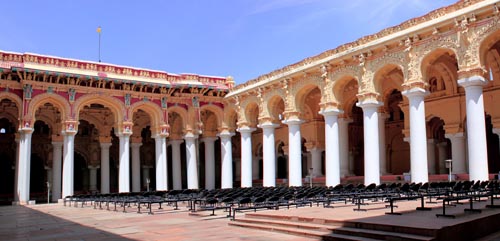Thirumalai Nayak Mahal

Information on Thirumalai Nayak Mahal (Madurai, Tamil Nadu) - History & Architecture
The Thirumalai Nayak Mahal which is located in the city of Madurai was primarily built in the 17th century. It was used as residence by the royal family of Madurai's Nayaka dynasty. It is quite big in terms of its size as compared to other monument during that period. The palace is primarily divided into two parts including Swargavilasa and Rangavilasa.
Thirumalai Nayak Mahal Architecture
As said earlier the palace has a touch of the Italian architectural style. It also has the fusion of both Dravidian and Islamic styles of architect in course of restructuring. In the construction foliated brickwork were used and even prime details were given in order to bring exquisite look with smooth and glossy texture. The Interior of the monument is at times shows the influence of Indian contemporary art. Notably, the inside of the palace is heavily decorated while the outside portion has a more serious style. There is an audience chamber within the palace that has cloisters of 12 m elevation. The palace is also well known for its each of which is 82 feet along with a width of 19 feet. The courtyard within the palace measures about 3,700 ㎡. It has circular pillars along with a big garden in the front. The portion of the palace used as royal residence depicts the apartments, theatre, shrine and armory used by the family members. The throne-room of the King has an arcade that is enclosed with a vault of 60-70 feet. Lord Napier the Governor of Madras, however after a long time tried to bring a change and renovated the palace and today as a result, we can see the Entrance Gate, The Main Hall and the Dance hall. Today, the unique architectural design with blend of Dravidian and Islamic style, bring to craft masterpiece and quite know for its gigantic pillars.
Thirumalai Nayak Mahal History
The palace i.e. Thirumalai Nayak Palace was established during the 17th-century with the specific year being 1636 AD. It was constructed during the reign of King Thirumalai Nayak of the Madurai's Nayaka dynasty in between 1623-59. The palace is at least four times bigger than that of other palace of that time. Tirumalai Nayak Palace is considered as a wonder of the south. The Nayaks ruled over the palace from the year 1545 up to 1740's. The period of 17th century, the kingdom of Nayaks has traders from England, Dutch and Portugal services had been taken while constructing the fort. However, in the later stages the king i.e. Tirumala Nayak an Italian architect to build the palace. The building over the 400 years of its existence has seen many renovation and refurbishing owing to the destruction caused by numerous battles. During the time of the East India Company to store their weapons and others materials. The recorded history for this particular palace suggest that Thirumalai Nayak's destroyed many parts of the monument to take out jewels and wood to make their own palace in Tiruchirapalli region. Lord Napier later restored the monument partially in between 1866-72 with the addition of an Entrance Gate and a Dance Hall.
Thirumalai Nayak Mahal Tourism Importance
This particular palace is positioned in 2 km south to the Meenakshi Temple in Madurai. The place i.e. Madurai being one of the most popular tourist destination of the state is conveniently connected with roadways, railways and airways. This make it easier for tourists to reach the palace. The monument is open for the visitors from 9.00 AM to 5.00 PM every day. There is also a sound and light show that take place within the palace in both English and Tamil further making it a suitable place for tourists all the world and India to visit.
- Andaman Nicobar Monuments
- Andhra Pradesh Monuments
- Assam Monuments
- Bihar Monuments
- Chhattisgarh Monuments
- New Delhi Monuments
- Goa Monuments
- Gujarat Monuments
- Haryana Monuments
- Himachal Pradesh Monuments
- Jammu and Kashmir Monuments
- Karnataka Monuments
- Kerala Monuments
- Madhya Pradesh Monuments
- Maharashtra Monuments
- Odisha Monuments
- Punjab Monuments
- Rajasthan Monuments
- Tamil Nadu Monuments
- Telangana Monuments
- Uttar Pradesh Monuments
- West Bengal Monuments